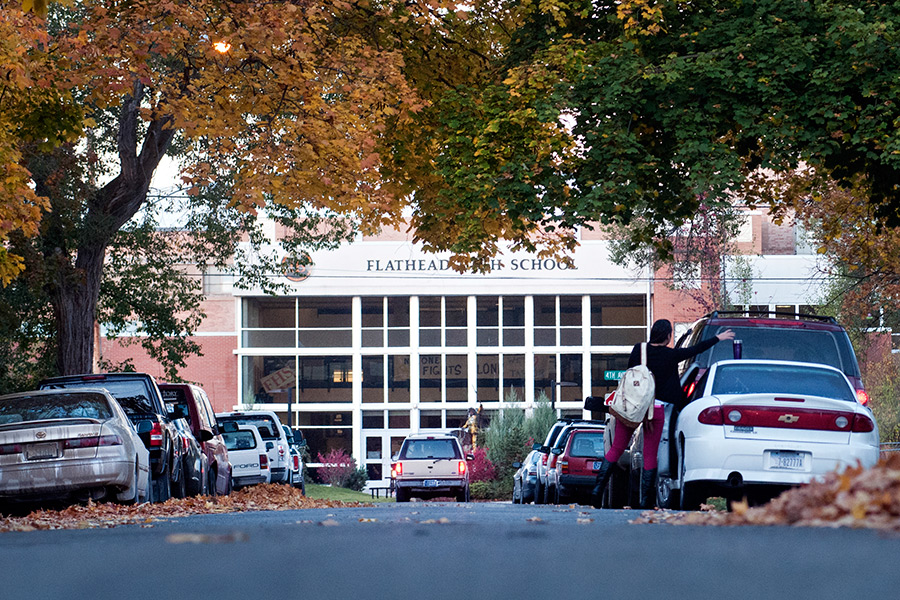There are 58 pages and counting of emails and letters, many emblazoned with emotional tones and statements — “utter chaos,” “myriad of dangers” and “community problem.”
Friction has built up over decades and led residents to organize a unified effort and take the debate public.
Last week’s regularly scheduled Kalispell Planning Board meeting, which would typically garner few spectators, if any, drew more than 40 people, many of whom spoke out during the two-hour forum.
At the heart of the issue is parking.
An age-old dilemma has regained attention in the west-side neighborhood surrounding Flathead High School, where a group of residents is irritated with congestion from the high school and Elrod Elementary School.
The residents have asked city officials to create a designated district that would require a permit for a vehicle to park on the streets and avenues within the proposed district. The district would encompass a three-block radius around Flathead. Only residents or landowners within the district would be eligible to purchase a permit, along with two visitor permits. The permit program would be effective 8 a.m. to 5 p.m., Monday through Friday, from Aug. 15 to June 15, except for holidays. The proposed cost for each permit has yet to be decided.
The request has received significant pushback from school administrators, students and other residents who have voiced their concerns over safety or plain disapproval of the paid parking program.
At last week’s crowded meeting in City Hall, both sides explained their respective positions, including a proposed compromise by the school district.
Mark Flatau, superintendent of Kalispell Public Schools, acknowledged the concerns of neighborhood residents but said the schools have made significant improvements in recent years and largely addressed the problem, making it unnecessary to implement the permit program.
Flatau cited police department statistics that show the rate of accidents related to students driving in the neighborhood has dropped by 50 percent in recent years, from 46 accidents within 1,000 feet of the school a few years ago to 23 last year. School programs have been created to pick up litter throughout the neighborhoods, he said.
Staff has also worked hard to ensure students use the school’s parking lot, which has been at 93 percent at capacity this fall, Flatau said.
Flatau acknowledged that the two schools do have a shortage of parking, estimated at 227 spots.
There are roughly 1,500 students and 130 staff members at the high school and 45 staff members at Elrod.
The high school has 307 parking spots available for students and 72 spaces for staff members on its property.
“We will continue to work with the neighborhood hoping to ensure that Flathead High School and Elrod Elementary will remain the good neighbors we’ve been for many, many years,” he said.
Flatau offered a compromise to the proposed permit program: the school district would expand parking in two areas at Elrod by reducing the number of 15-minute parking spaces and replacing part of the playground with parking spaces. At the high school, Flatau said the district could eliminate a portion of grassy area, including the site of a new garden maintained by the school’s Environmental Club, and replace it with parking spaces. Eliminating the green space was among the most contentious ideas within the school district, Flatau said, and students within the Environmental Club spoke out against it at last week’s meeting.
Flatau said eliminating the current garden for parking was a hard decision, but the school has found itself with few other choices.
All together, these changes would create nearly 70 new parking spots, which could address many of the residents’ complaints, Flatau said.
Also, the schools are asking that residential parking permits be issued only on the west sides of Third Avenue West and Fourth Avenue West instead of throughout the entire grid of streets surrounding the schools.
“The solutions to the parking issues, we believe, need to be viable for both residents and schools,” Flatau said. “I just know it’s not an easy solution.”
During the public comment period, students and parents spoke out against the permit program because of its risk to student safety. By creating the parking district, students will only park further away from school, forcing them to travel along streets that often do not have sidewalks or street lights. This would also put students further away from the watchful eye of school staff.
One teenage girl, a sophomore at Flathead, cited her fear of nearby sex offenders living in the area, noting that there are four registered offenders within the proposed parking district and 12 within two blocks of the boundary.
“If this parking district is created, it is very possible that I could be walking over two blocks to get to my truck,” she said. “This is dangerous in so many ways.”
Yet residents who support the district offered their perspective, which features consistently clogged streets that prevent visitors or city services, including ambulances, from accessing the neighborhood.
“Not only is it difficult for services to access our homes due to students and faculty parking, but also, the streets are bottlenecked, allowing for one-lane traffic only, creating a myriad of dangers for the people who reside in these areas,” Devin Kuntz wrote in a letter to the City of Kalispell expressing his support for the district.
Kuntz and others said the school district’s compromise did not go far enough in addressing the problem.
After the conclusion of public comment, Planning Board Chairman Chad Graham said he and the other members had a lot of information to digest and that the board would readdress the situation at its Oct. 28 work session in City Hall. The meeting starts at 7 p.m.
Click here to read the planning board notes and letters regarding the parking district.
